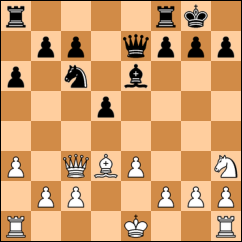After I opened 1.d4, Will said, "I know what I could do, but I'm not going to do that to you." He played a Semi-Slav. Doh!
K.Ammann–W.Engel
Route 20 Chess Club Championship (3)
Freeport, Ill., Dec. 21, 2010
1.d4 d5 2.c4 c6 3.Nf6 e6!?
Will postpones ...Nf6, presumably for the extra tempo.
4.Nc3 dxc4!? 5.a4 Bb4 6.Bd2?
My first opening stumble. I was concerned about being unable to use the knight and/or my b-pawn to break down Will's pawn structure on the queenside. But the book line is 6.e3 b5 and only then 7.Be2 (if black plays anything else on move 6, white can then take on c4 right away).
6...Bxc3 7.Bxc3
Preserving freedom of movement and the ability to break down Will's queenside pawns with b3.
7...Ne7
Will's first opening stumble. There's no good reason to play anything except 7...Nf6, especially with my queen's knight gone.
8.e4 b5 9.b3 cxb3
At this point, I need to remain calm and realize that the pawn on b3 has nowhere to go, not with my bishop on c3. The key square is b5: if I play 10.axb5, I win my pawn back and enjoy a significant positional advantage. Unfortunately, I go into a momentary fog and fail to realize the importance of the move order.
10...bxa4 11.Qxa4 0-0 12.Bc4 Nd7 13.0-0 Nb6 14.Qa2 Nxc4 15.Qxc4 a5
Remarkably, according to Fritz, my development is so good that, despite being a pawn down, I still have the advantage. Can't have that. I'd better do something about it.
16.Ne5??
I've overlooked the potential skewer along the a5–f1 diagonal, which 16.Qc5 sidesteps. Will hasn't -- in fact, it's probably why he played 15...a5 -- and wrests the advantage away from me.
16...Ba6
At this point, having twice failed to spot tactical shots against me that I feel I should have been aware of, I force myself to slow down and look for a constructive way out of this mess. What I eventually discover is a nice bit of counterplay that keeps things from getting any worse than they already are.
17.Bxa5 Bxc4 18.Bxd8 Rxa1 19.Rxa1 Rxd8 20.Nxc4
Amazingly, I've even managed to win back the pawn I was down! But while before I was materially down but had an advantage owing to better position, the situation is reversed: We're materially equal, but Will has the better position and the advantage now.
The question in my mind is what to do about my d-pawn. Just as I realize that Will can't take it -- if he does, then 21.Ra8 leads to a back-rank mate -- he makes one quiet little move that says, "Yes, I can."
20...f6
Now his king has an escape square, and the mate is mooted.
21.Rd1 c5 22.d5 exd5 23.exd5 Rxd5
Not 23...Nxd5? 24.Ne3, which turns the tables.
24.Rxd5
Being down a pawn again, I probably shouldn't be chasing trades. But at this point, I'm thinking about the endgame -- specifically, that if I can get the rooks off the board, it might be easier for me to obtain a draw. This is going to take some doing, since the passed pawn that Will now has gives him a decisive advantage.
24...Nxd5

25.g3 Kf7 26.f4 Ke6 27.Kf2 Nb4 28.Ne3 f5 29.Ke2 Nc6 30.Kd3 Na5
I'm not doing badly at all here, but I'm starting to get a little frustrated. Where is my break going to come from? I can't trade knights until our pawns are equal, and I shouldn't sacrifice my knight unless I can be certain that either his knight will go or his last pawn will. Meanwhile, Will's paired pawns on c5 and f5 prevent any sort of a breakthrough. Rather than continue to dance around, I take a gamble.
31.g4?! fxg4 32.Nxg4
I'm better off seizing the opening with 32.Ke4.
32...Kf5
Ouch. Now I'm going to be two pawns down if I'm not careful. Looking at the arrangement of Will's pawns, I get a new idea: working my way around to e6 for a fork.
33.Ne5 Kxf4
With my f-pawn immobilized, Will can humiliate me with 33...g5!? 34.Nf3 Kxf4.
34.Nd7 Nb7 35.Nf8 Kg4 36.Nxh7 Nd6
New problem: I can't get to e6 anymore. If I play 37.Nf8, then 37...Kf5 guards the square. This is, in fact, my best course of action, despite the concomitant failure of my plan. Desperate, I try to pull Will's king away from where I want my knight to go.
37.h3+?? Kh4
Will should simply take the pawn.
38.Kc3??
My endgame-sense is failing me. Which pawn is Will going to try to promote, the one far from his king or the one near it? I should simply play 38.Nf8, now that Will can't cover e6 with his king anymore.
38...Kxh3 39.Ng5+ Kg4
39...Kh4!? makes hash of my fork plan by covering g5 so that Will's g-pawn can make a dash for it: 40.Ne6 g5 41.Nxc5 g4.
40.Ne6 g5 41.Nxc5 Kf3 42.Nd3 Ke3 43.Ne5 Ne4+ 44.Kc4 Nf2
Just one pawn to go. How to get in front of it?
45.Ng6??
Not like this. 45.Nf7!, despite looking completely ineffectual, achieves the draw because of 45...g4 46.Nh6 g3 47.Nf5+ Kf4 48.Nxg3.
45...g4 46.Nh4 Nd1 47.Ng2+?! Kf2
47...Ke4 48.Nh4 holds on.
48.Nf4 Kf3 49.Nh5 Ke4??
Immediately after making this move, Will sheepishly extends his hand and says, "You see it, don't you?" And I do: The fork 50.Nf6+ Kf4 51.Nxg4 wins the last pawn.
½-½
And so it was that I achieved my goal for the evening by fighting Will to a draw, and that Will won the well-deserved title of Route 20 Chess Club rated champion on the tiebreak. Congratulations also to Ryan Ekvall, our unrated champion. Complete crosstables are on our Tournament Results page.
No meeting Dec. 28 or Jan. 4 -- happy holidays, and see you next year!
Round 3 games in Chessbase format: Route 20 CC Ch 3.cbv

















